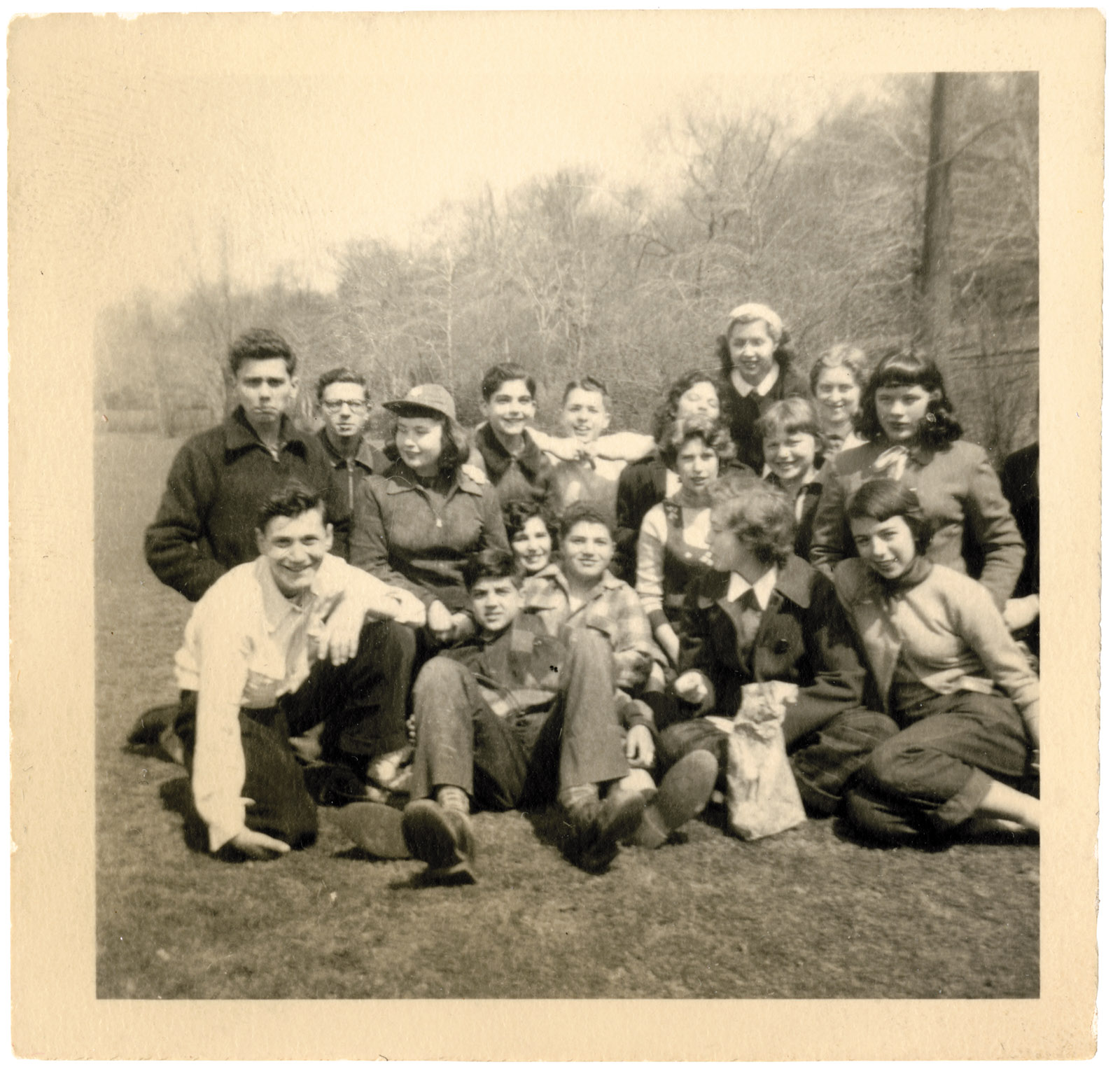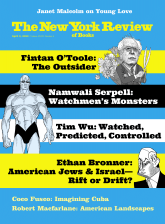
There is a box in my apartment labeled “Old Not Good Photos.” This is an understatement. Most of the photos are two-and-a-half-inch squares, showing little blurred black-and-white images, taken from too far away of people whose features you can barely make out, standing or sitting alone or in groups, against backgrounds of gray uninterestingness. They are like the barely flickering dreams that dissipate as we awaken, rather than the self-important ones that follow us into the day and seem to be crying out for interpretation. However, as psychoanalysis has taught us, it is the least prepossessing dreams, disguised as such to put us off the scent, that sometimes bear the most important messages from inner life. So too, some of the drab little photographs, if stared at long enough, begin to speak to us.
A picture of seventeen high school boys and girls, sitting on the grass and mugging at the camera, takes me to a deep blue sky punctuated by the silhouettes of minarets. I have never been to the Middle East. The memory of the minaret-studded sky comes from a movie house called Loew’s 72nd Street, where I saw many movies in my childhood and youth and where one of the boys in the picture, Jimmy Scovotti, worked as an usher on weekends. Before the house darkened and the movie came on, one sat in a kind of Orientalist dream. The interior had been done up as an Arabian Nights palace. I don’t remember being especially thrilled by it—Loew’s 72nd Street was not the only movie house where this sort of entertainment was added to the celluloid entertainment—but I enjoyed it as I enjoyed the other now preposterous-seeming amenities of the 1940s. It was my first encounter with the clichés that Edward Said’s great book held up to view.
I don’t recognize any other boy in the photograph. I only recognize a girl named Natalie Gudkov and myself. I know the picture was taken at an outing to a place in Yonkers called Tibbetts Brook Park, but I remember nothing about the outing itself, or why I was there. I know these were kids I did not have much to do with in high school. None of the boys were the ones I was in love with during those years. As I write the words “in love,” the picture—I was about to say dream—begins to speak, a bit too fast, about the habit of love we form in childhood, the virus of lovesickness that lodges itself within us, for which there is no vaccine. We never rid ourselves of the disease. We move in and out of states of chronic longing. When we look at our lives and notice what we are consistently, helplessly gripped by, what else can we say but “me too”?
In “Observations on Transference-Love” (1915), the third in a series of papers on analytic technique that formed a sort of operating manual for analysts in the early days of the profession, Sigmund Freud alerted new practitioners (none of whom were women) to one of its occupational hazards. Women patients, he warned, are going to fall in love with you, but don’t think that this is “to be attributed to the charms of [your] own person” or that it is real love. It is a peculiarity of the treatment, a form of resistance to it. Whatever you do, don’t reciprocate, but see what you can do about persuading the patient to stick out her lovesickness and remain in the analysis, which will eventually cure her of the problems with love that brought her to it in the first place. The analyst
must take care not to steer away from the transference-love, or to repulse it or to make it distasteful to the patient; but he must just as resolutely withhold any response to it. He must keep firm hold of the transference-love, but treat it as something unreal, as a situation which has to be gone through in the treatment and traced back to its unconscious origins and which must assist in bringing all that is most deeply hidden in the patient’s erotic life into her consciousness and therefore under her control.
Freud goes on to spell out the difference between transference-love and “genuine love.” He argues that if the patient were truly in love with the analyst, she would try to help him with the treatment rather than to sabotage it. And “as a second argument against the genuineness of this love we advance the fact that it exhibits not a single new feature arising from the present situation, but is entirely composed of repetitions and copies of earlier reactions, including infantile ones.”
Then Freud makes one of the sly rhetorical turns by which his work is marked and that give it its special potency. He anticipates the reader’s objection to what he is saying by agreeing with it: “Can we truly say that the state of being in love which becomes manifest in analytic treatment is not a real one?” No, we can’t. “It is true that the love consists of new editions of old traits and that it repeats infantile reactions. But this is the essential character of every state of being in love.” He goes on:
Advertisement
Transference-love has perhaps a degree less of freedom than the love that appears in ordinary life and is called normal; it displays its dependence on the infantile pattern more clearly and is less adaptable and capable of modification; but that is all, and not what is essential. [italics mine]
Freud ends the paper by returning to his admonitions. Yes,
sexual love is undoubtedly one of the chief things in life, and the union of mental and bodily satisfaction in the enjoyment of love is one of its culminating peaks. Apart from a few queer fanatics, all the world knows this and conducts its life accordingly.
But the analyst must stand firm against the temptation to return the patient’s love. He adds:
It is not a patient’s crudely sensual desires which constitute the temptation…. It is rather, perhaps, a woman’s subtler and aim-inhibited wishes which bring with them the danger of making a man forget his technique and his medical task for the sake of a fine experience.
A fine experience. If we read “Observations on Transference-Love” with the evenly hovering attention with which the analyst is taught to listen to the patient’s monologues, we are struck with the language that Freud allows into his scientific paper, the language of ordinary life lived in pursuit of erotic experience. It is Freud’s honesty that rises above his ambitions as a scientist and forces him to acknowledge that this thing called transference-love is a pretty wobbly notion, if not a cover-up for the attraction that develops between a man and a woman who meet every day in a small room and talk about intimate things while one of them is lying down. The concept of transference, the idea that we never see each other as we “are” but always through a haze of associations with early family figures, is the matrix of psychoanalytic therapy. The analyst draws the patient’s attention to what he doesn’t notice in regular life, to the stale old drama he feels compelled to play out with every new person. He proposes an alternative script to this comedy of misprision. But Freud acknowledges—and never with more rueful force than in “Observations on Transference-Love”—the enduring injuries of our hapless earliest erotic encounters.
At the time of the Tibbetts Brook Park outing, I had, of course, not read Freud’s paper, and would not read it for many years. But another text on abstinent love was well known to me: a best-selling novel called Seventeenth Summer by Maureen Daly, first published in 1942, that chronicled the summer romance of a seventeen-year-old girl named Angie Morrow and a boy of the same age named Jack Duluth who lived in the Wisconsin town of Fond du Lac and never did anything more than kiss. Rereading the book years later, I recognized it for what it was—a tract for the repressive sexual ideology of the time, whereby nice girls didn’t “go all the way” and nice boys hardly expected or wanted them to, given their own nervous-making sexual inexperience. But in its day, the book only encouraged underinformed teenaged girls like myself in our longings for sexless romance, and never disturbed the curtain of humorlessness through which so much of postwar American reality was filtered. When Angie recalled her first date with Jack on a boat—“I remember thinking when he was so close how much he smelled like Ivory soap”—we did not laugh. How else should a boy worthy of love smell?
The metaphors of cleanness vs. dirtiness form the book’s understructure, instantiate its opposition of purity vs. corruption. Whenever Jack appears, Angie, who is no slob herself—she is always ironing or changing sheets or drying dishes—immediately and happily notices how much cleaner he is than any other boy. (“His shirts always seemed clean when other fellows’ were warm and wrinkled.”) The dirty act of sex is represented by nature, by the dark, muddy water and slimy weeds of the lake and trees,
bent low, twisting and moaning, wrenching at their trunks and writhing in a strange sympathy with the tormented water. Gray waves rolled crashing toward the shore and thrashed against the wooden pier, slapping like bare hands against the flat rocks. High sprays of foam tossed into the air and the wind was heavy with the damp, suggestive smell of fish.
Lest the reader allow the suggestiveness of the nature passages to lead her, even just in thought, from the sex-fearing straight and narrow, Daly introduces a cautionary subplot involving Lorraine, Angie’s sister, who isn’t beautiful and natural the way Angie is—she is always putting her hair in curlers and covering her face with cold cream—and who, in her desperation to keep him interested in her, succumbs to the demands for sex of a “fast,” unpleasant, older (in his twenties) guy named Martin. We never learn whether the ill-favored Lorraine went all the way with Martin, or just allowed him the liberties then known as “petting” or “heavy petting.” “Things are different now from the way they used to be,” Lorraine defiantly says to Angie during the confessional scene in which we learn of her transgressions. “Now everybody does it and nobody thinks…you know what I mean…” But later she piteously admits, “This isn’t how I meant to grow up. I’ve heard of other girls…but that isn’t how I meant to be.”
Advertisement
Daly’s tale of careful love is still in print. Among the responses to the book on Amazon, my favorite is from a reader in her twenties who just bought a copy for an eleven-year-old and isn’t sure how the gift will be received. “For an 11 year old girl that daydreams about kissing boys, she’d probably like it. For an 11-year-old girl that’s already had sex, the book may seem ‘lame.’”
This Issue
April 9, 2020
Bigger Brother
Stuck
In the Time of Monsters



